In the years since Eagle Dynamics released the DCS: F/A-18C Hornet, I’ve never actually written a full review of the aircraft and I thought it was long past due that I close that gap. Now that they have put most (though not quite all) of the finishing touches on the jet I figure early 2023 is a good time to review the F/A-18C for DCS World. As popular as the Hornet already is, not everyone has it and plenty of new DCS World virtual pilots are asking if its the jet for them. Hopefully this review will help you decide if this is something you want to purchase. Also, if you’re a fan of the DCS: F/A-18C Hornet and you want something with some Stormbirds flair, scroll to the end for a special bonus. And now, on with the Hornet review!
A bit of history
As is my style, I always like to start with the real world history of the airplane and then tie that into the review of the virtual version.
The F/A-18 Hornet has a unique history that connects it with the USAF’s light fighter project. The concept was called “high-low” and the idea was to create two series of fighters. The F-15 was already becoming established as a high capability fighter with the performance and weapons load to tackle the best fighters around. But it was too expensive to field in the numbers needed so a lighter and simpler fighter was needed to fill in the “low” part of the capability mix. That led to two prototypes, the YF-16 and YF-17, that were ultimately designed and flown. The Lockheed’s YF-16 would win the competition and go on to become the multi-role F-16 fighter that we all know. That was not to be the end of the story for the YF-17 however.
At around the same time, the US Navy was looking towards developing a new attack and fighter platform to replace a myriad of types that were occupying its flight decks. McDonnell Douglas pitched two aircraft using a single airframe. The F-18 and A-18 were intended to use a modified YF-17 design with different avionics packages and common parts depending on the fighter or attack roles that the Navy wanted to focus on.

Around this time, the microprocessor revolution was starting to take hold and it became possible to glue the fighter and attack versions together with just a single avionics package enabling one jet to take on a number of different roles. The F/A designation was born and the US Navy picked the F/A-18 Hornet to take on the task.
Like some more recent fighter projects, the F/A-18 Hornet had a protracted development period and the advanced nature of the jet’s systems made it initially more expensive than planned for. However, over time the capability of the jet would prove itself to the point where the Hornet and follow-on Super Hornet have come to dominate the carrier decks of US Navy carriers for the last 30 years.
The Hornet in DCS World

The introduction of the DCS: F/A-18C Hornet into DCS World has been a significant one. It has been a trailblazer for the DCS World series on a whole and it has paved the way for other modules by both Eagle Dynamics and by other third party developers. That has come with some growing pains but we’ll get to that.
The Hornet is such a versatile aircraft that it has been used as a platform to build technology that has since gone on to be shared by multiple aircraft across the whole of the simulation. Some of those technologies we now take for granted in DCS World were not present in any sophisticated way back in 2017 when it first released into early access. That list includse more sophisticated air-to-air radar modeling, the air-to-ground radar system (and associated APIs for third parties), helmet mounted displays, CATOBAR style aircraft carrier operations with both the free USS Stennis as well as the separate DCS: Supercarrier module, and Link16 datalink functionality as just some of the technology that has been developed.
All of these technologies have been foundational and much of it has been pushed along by the introduction of the Hornet. This project has had a significant impact on DCS World even if you fly other jets and I think that’s worth noting.
What’s it like to fly
This is an aircraft that is, like the F-16, inherently unstable by design. This gives the jet enormous potential for agility but to make it a competent aircraft for human pilots, computer control is required. The fly-by-wire system that controls the jet intervenes and manages all stick inputs and helps you fly the aircraft. Eagle Dynamics has modelled this system in detail right down to characteristic wiggle of the control surfaces during the start-up and even during certain areas of flight as the system works to keep the aircraft in full control. As a result of the fly-by-wire system, the Hornet is remarkably easy and stable to fly. At the same time, it can turn tightly and point its nose with pitch authority that few other aircraft can muster.
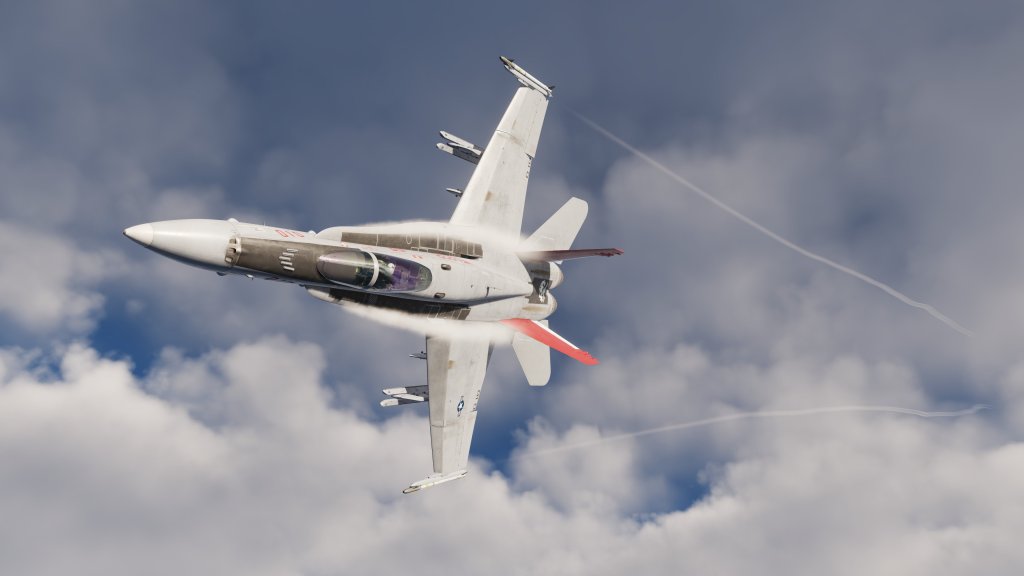

Many find this to be a detriment to their flying experience as they want a more hands-on jet. To be clear, this isn’t easy mode for jet fighters, as you can still find yourself in a whole bunch of trouble but it does make it easier to manage. For those of you who prefer to have their jet want to kill you at every step of the way, other jets like Heatblur’s excellent F-14 might be more your style. I see the appeal to both and for the Hornet the fly-by-wire system does have its advantages.
Given the complex mission sets, the difficult threat environments and the hostile places that the Hornet sometimes finds itself in, I’m just as glad that jet itself isn’t trying to kill my virtual pilot. The Hornet (mostly) gets out of your way and lets you get on with the business at hand.
Energy management is still key with the Hornet and keeping speed up with this jet is a bit more challenging than the slippery F-16 or powerful F-14. That gets especially true when the F/A-18 is loaded down with missiles, fuel tanks, targeting pods and ordinance. You can find yourself having bled off too much speed, pulling too high an alpha, and at full afterburner struggling to get your speed back. This is the F/A-18’s Achilles heel and its worth keeping in mind.
Fully capable of just about everything
Another mark in the DCS: F/A-18C’s corner is its value as a module. The real-world Hornet and the virtual one are highly capable aircraft able to do almost any task and that makes its $79.99 USD price tag somewhat more worthwhile as you can get what essentially amounts to the complete DCS experience all in one jet.
In the air-to-air arena, the F/A-18C Hornet is fully capable with weapons, sensors, and datalinks to do the job. It can carry AIM-9 Sidewinders including the impressive AIM-9X. It also has medium range semi-active radar homing missiles like the AIM-7 series and the active radar seeking AIM-120B and C series.
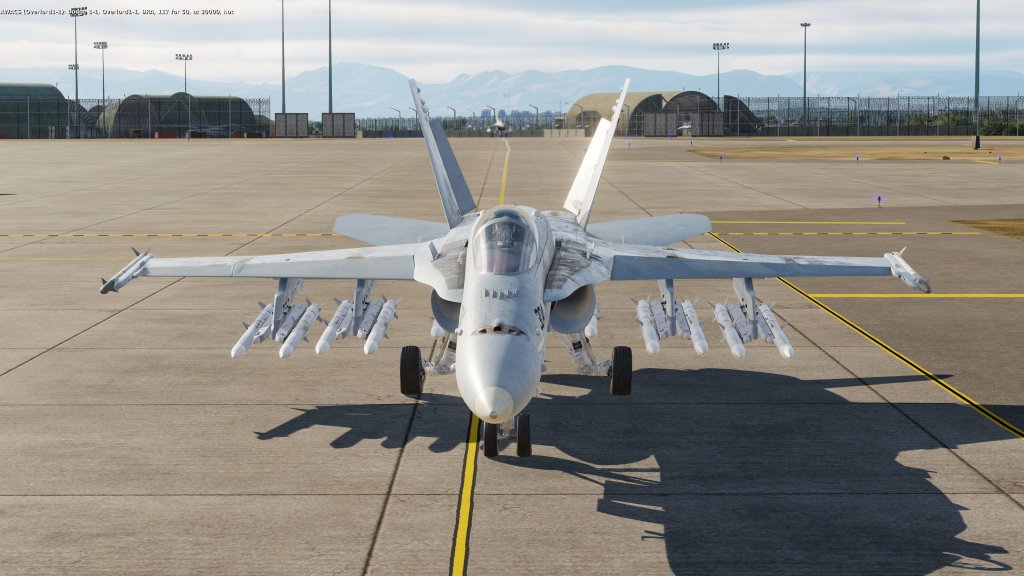
Notably, the Hornet can be maximally loaded with ten AIM-120C missiles and still have room for a fuel tank and a pair of Sidewinders. Though this is a draggy configuration and one not often recommended, it is still a possibility for where magazine depth is more important than outright performance.
For air-to-ground, the weapons list is extensive including the standard array of MK82, 83 and 84 bombs as well a long list of the GBU series of weapons including the laser tracking GBU-12, 10 and 16 as well as the GPS guiding GBU-31, 32 and 38. There’s also the AGM-65E and F, the Maverick variants used by the US Navy, as well as the AGM-158 JSOW, the AGM-84D Harpoon, the AGM-84E SLAM, the AGM-84 SLAM-ER, AGM-62 Walleye, and the AGM-88 HARM. That’s not even the complete list but it does give you an idea of the range of air to ground munitions.

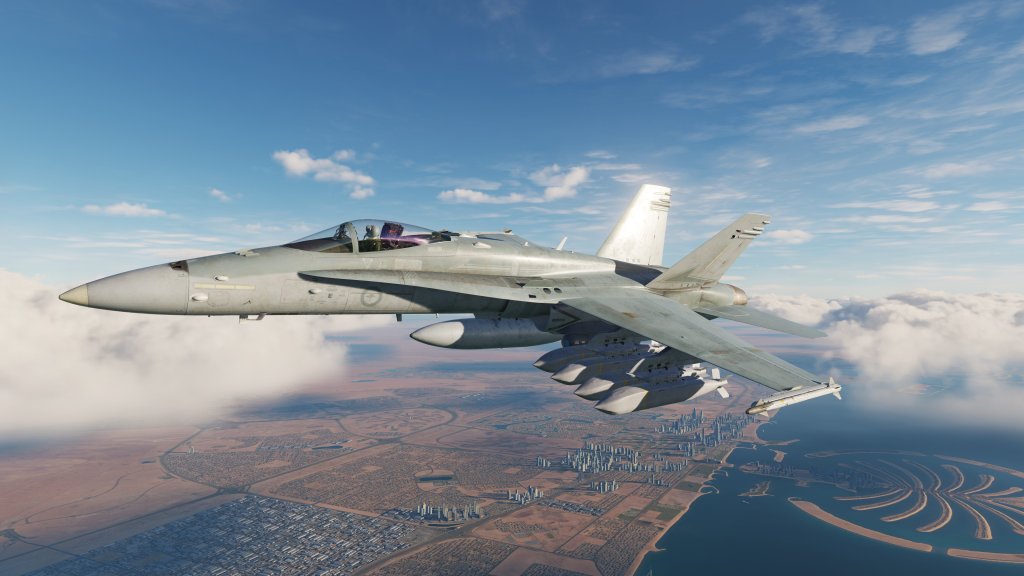


And of course the Hornet also can fall back on the M61 Vulcan 20mm cannon which makes short work of most aircraft and light ground targets.
Together this wide array of weapon systems enables the Hornet to take on virtually all-comers both in the air and on the ground.
Many of my own missions online have been flown using the JSOW, JDAM and HARM series weapons but I’ve also used virtually every other weapon system at one time or another. Of the list, the one that is perhaps the most disappointing is the AGM-84D Harpoon which doesn’t strike with enough speed or power. In some scenarios, when facing guided missile cruisers, it required several Hornet’s and a barrage of dozens of Harpoons just to ensure that at least a few of the missiles make it through – on the other hand, smaller ships are easily dispatched.
Sensors galore
The long list of weapons isn’t the only thing that the Hornet relies on in combat scenarios and for that we turn to the various sensor systems which warrant their own section.
First, the air-to-air radar which has a bit of a complicated reputation. Though the simulation of this is highly detailed, it has also been one of the least consistent features throughout the Hornet’s development. In some instances, the radar has been reliably tracking targets out to about 70-80nm. In other cases, its struggled to even find targets that it should be able to see and then been fussy abut locking or not locking onto a target. Most of those issues have been resolved over the last couple of years but I’m not fully convinced we won’t see them crop up from time to time as Eagle Dynamics keeps tweaking the system.
However, when it does all work correctly and I’ve dialed in the correct settings, the radar is quite capable. Not as far reaching as the F-14, F-15 or even the F-16 but still quite good.
In one scenario online, I was facing approximately 10 enemy aircraft and together with some friends, were able to splash all of the aircraft without a single loss. Making full use of the AIM-120C and the radars Track While Scan (or TWS) mode, I was able to simultaneously lock multiple targets and switch between them. In this instance, I was able to lock and fire an AIM-120C at four targets with four aircraft being destroyed in rapid succession. It doesn’t always work out that way but it does show that the F/A-18C can be very capable when armed to the teeth with weaponry.
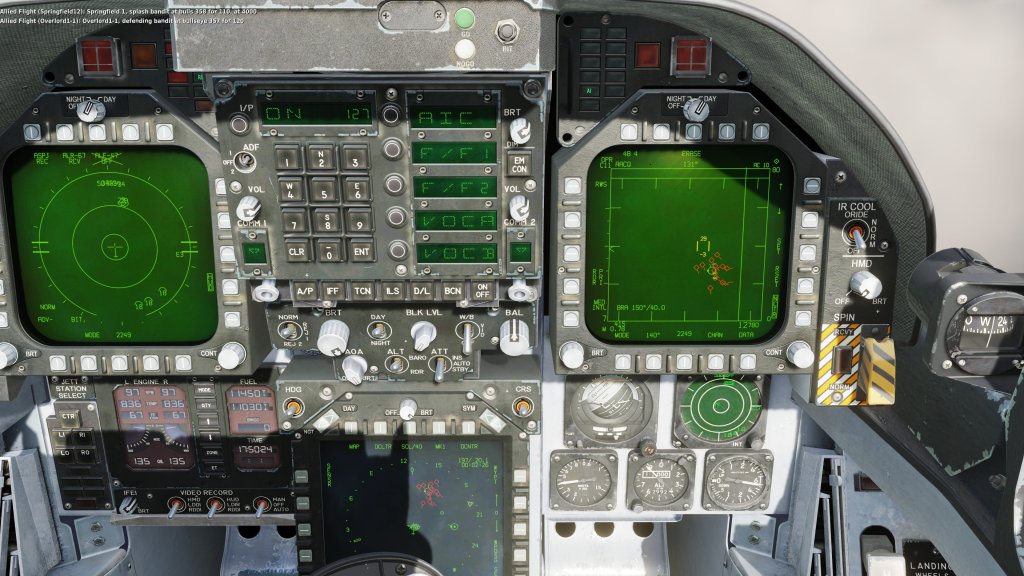


Another feature in the Hornet’s corner? Datalink! The Link 16 system is not unique to the jet but it was the first DCS World jet to receive a more detailed implementation that includes both feeding-in and out sensor information across the whole of the network and incorporating that into a bird’s eye view of the situation.
Friendly and enemy aircraft get their positions plotted on the map together with other contributing aircraft. That includes the E-2D Hawkeye and E-3 Sentry AWACS aircraft which means that you have the whole AWACS picture on a display on your cockpit. You can then match that with your own radar and engage or avoid enemy aircraft as desired.
When it was first implemented I couldn’t believe just how much of a gamechanger the system was to my flying. Whatever inadequacies the Hornet’s radar has, the ‘SA’ page on one of the Hornet’s three multi-function displays will easily make up for it.
So too will the JHMCS helmet display that lets you look around and see your aircraft state, designate targets, get a feed from the datalink and engage some kinds of targets. That especially so with the AIM-9X missile which you can hit targets 90 degrees off from the direction you’re flying.
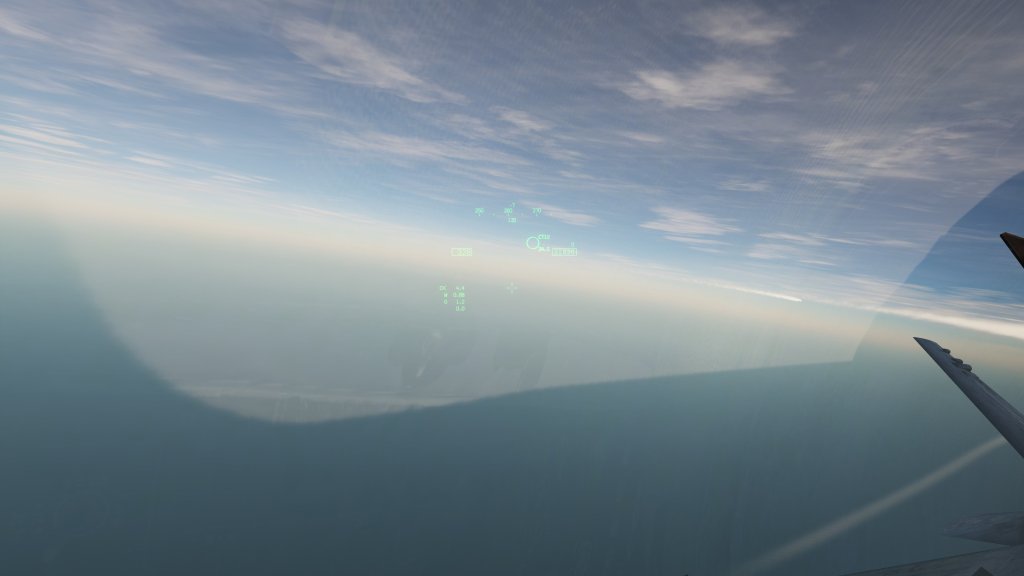
Hornet also comes with two targeting pods. We have both the Litening II and ATFLIR pods and both can be mounted on the cheek station of the Hornet or under the jet on the central mounting point in the case of the Litening II. Both pods give the Hornet impressive target identification and surveillance as well as the ability use GPS and laser guided weapons with precision. Both pods are functionally similar with slightly different procedures – for realism sake the ATFLIR is a US Navy pod rated for operation aboard ship while the Litening II are used by the USMC and by several allied nations.
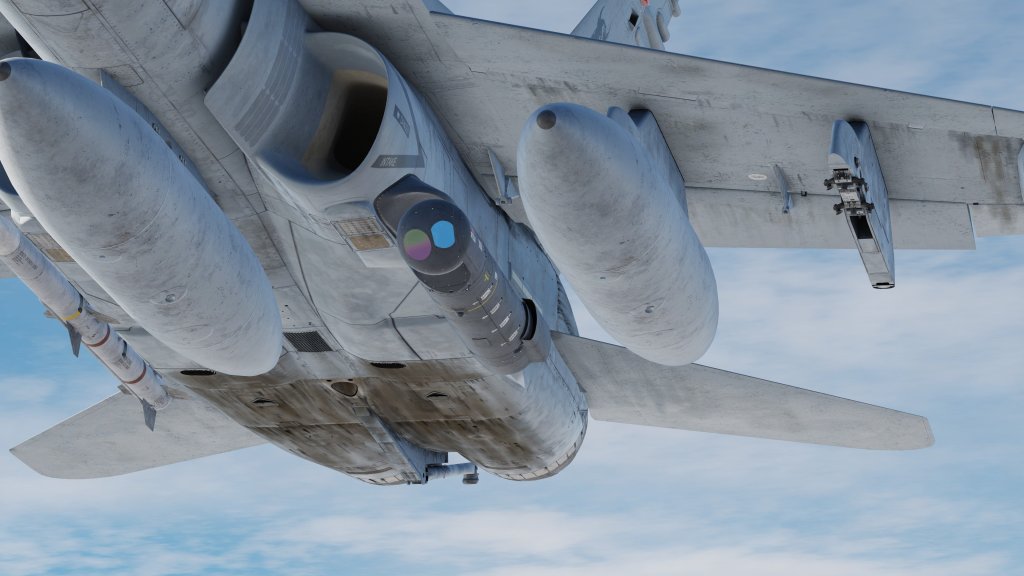
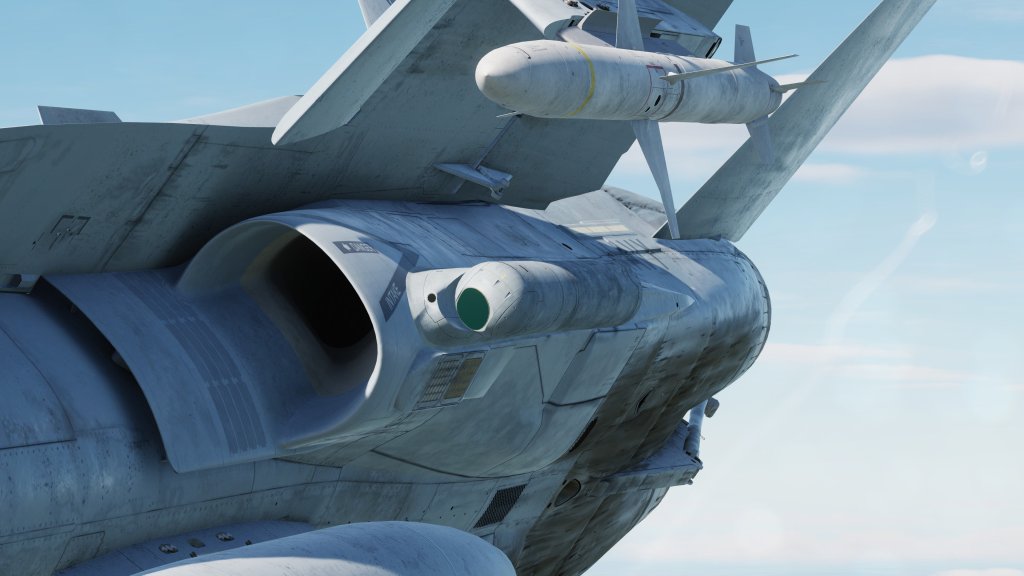
The Hornet has also been the testbed for DCS World’s new air-to-ground radar modeling which has since proliferated to other aircraft. The Hornet’s AG radar can identify land formations, pick out targets with the impressive expand modes, or highlight radar signatures such as ships and moving vehicles for precision weapons lock. This system has generally been very reliable and useful in situations with moving targets. In particular, the SEA mode is very useful at locking ship targets to then be followed-up by a Harpoon missile strike.
Carrier operations



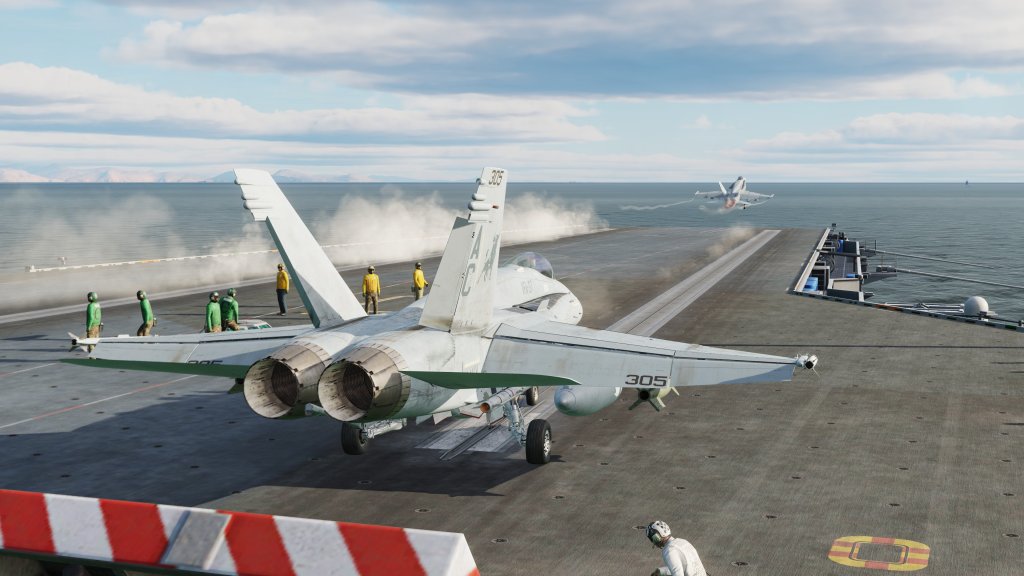


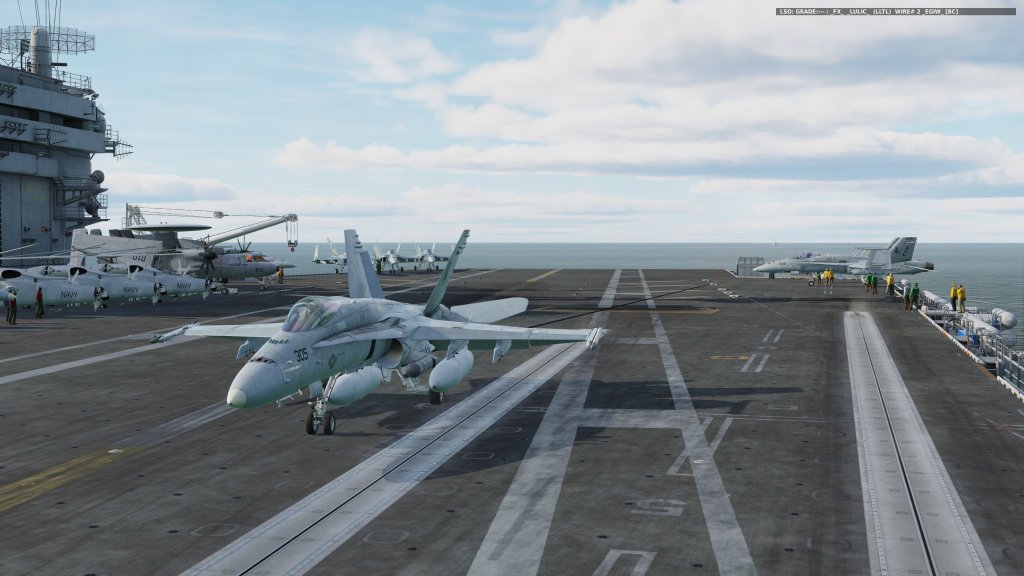
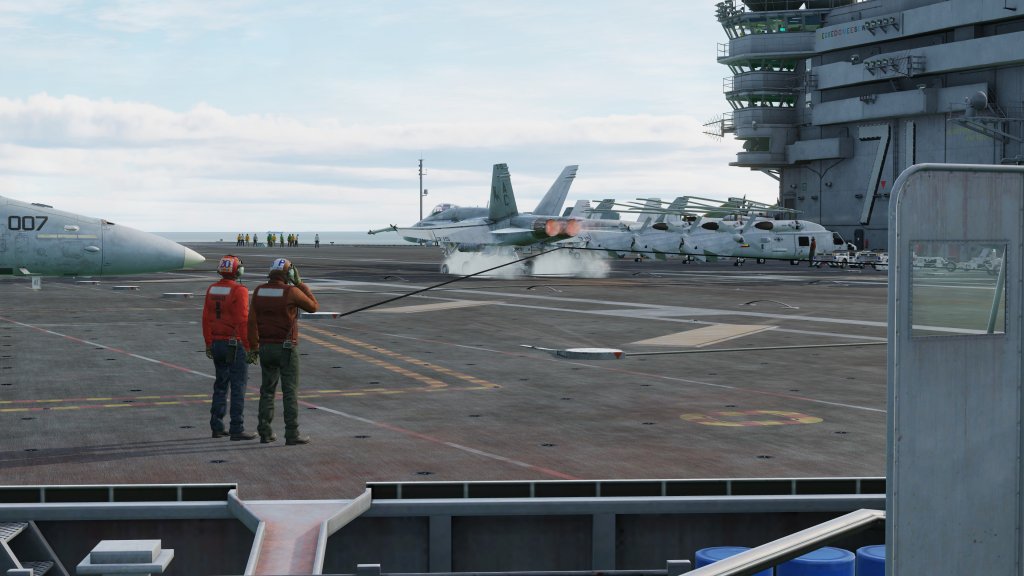
If all of the capabilities above wasn’t enough, the F/A-18C Hornet is also a carrier capable fighter and DCS: F/A-18C Hornet was the first full fidelity module to bring CATOBAR naval flight operations to DCS World. Half of the fun of flying the Hornet has been in learning how to land the aircraft on the carrier deck. Doubly so if that deck is obscured by weather or at night.
The DCS: F/A-18C Hornet module on its own without anything else can use the USS John C. Stennis aircraft carrier. It’s functional and for a long time it was the only carrier we could operate from. Since then, Eagle Dynamics have released the separately sold DCS: Supercarrier module which is currently being developed. Without Supercarrier you don’t get the deck crew, carrier stations like the LSO station, or the more authentic radio communications but its still very functional and very fun without it. Supercarrier does, on the other hand, add another layer of authenticity and it pairs well with the Hornet and with the F-14 Tomcat too.
Launching from the deck of a carrier is a tremendous rush which has never once gotten old for me. The instant acceleration and into the air experience is uniquely thrilling. Landing on the deck of a ship is equally entertaining although intensely challenging at even the best of times. It is largely regarded as one of the most difficult things you can do as an aviator in real life and I would wager that this is also true in a flight simulator. It requires the utmost concentration and focus to achieve but the satisfaction is immense when you pull it off.
Is it easy to learn?
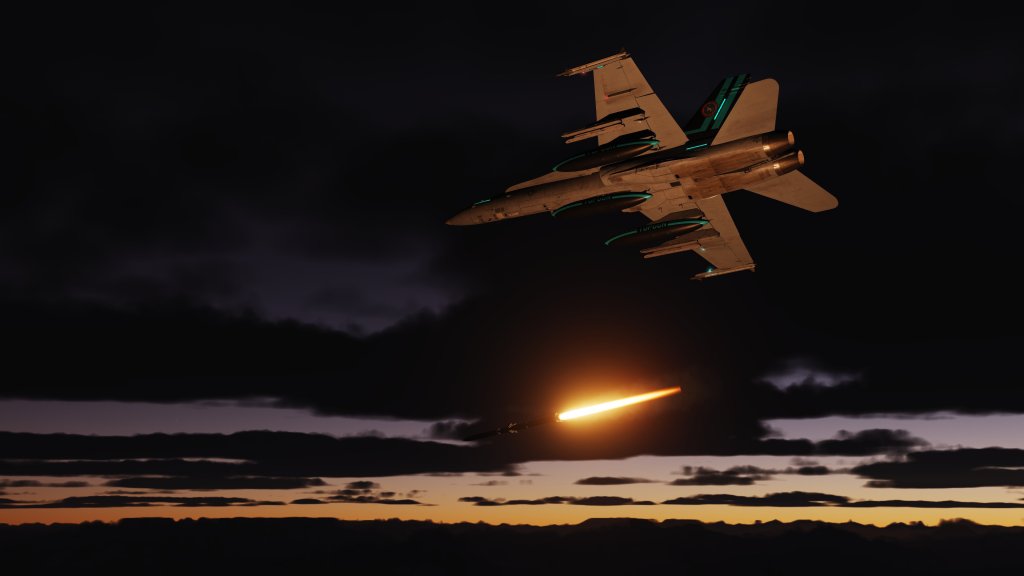
Now comes a tough question and that’s about how easy it is to learn how to fly the Hornet and use it in operations.
The short answer? Yes, but only if you are choosy about the capabilities that you want to learn.
Because the Hornet can do so much, you can get overwhelmed with trying to learn every feature. To date I’ve done most of it at least once but some features/weapons I rarely use. Beyond the start-up process, I recommend that people make sure they are comfortable with the Hornet in the air-to-air role first with a command of its radar and how to lock and fire missiles in both the standard and air combat manoeuvring/ACM modes.
If you decide that you want to do more strike missions then you may want to invest some time to learn one of the two available targeting pods and pair that with weapons like the JDAM and JSOW. These are highly capable weapons and essential for any strike mission. Notably, the workflow for the JDAM bombs is almost the same as the one for the AGM-154 JSOW so that means that you can learn two weapons at once – albeit with widely different employment styles.
Using the laser guided GBU-10, 12, and 16 series is not dramatically different either so these are a natural combination as well.
There’s also weapons like the AGM-88 HARM, which when used in self protect or SP mode, are also very easy to employ. Lock an emitter on your RWR and fire the missile when in range. There are more capable modes but they are also a bit more complicated and I like to keep things simple when starting out.
Manage all of that and you’re already very capable with the Hornet handling air to air and air to ground operations against a very long list of potential targets. You can expand your capabilities from there adding things like aerial refuelling, carrier landings, the AGM-84D Harpoon anti-ship missile and AGM-84E/H SLAM and SLAM-ER long range cruise missile, or the old school AGM-62 Walleye. Or you could just elect to drop some unguided bombs too. With the Hornet you have so many options!
There are a huge number of tutorials out there including Chuck’s Guides for F/A-18C, Matt Wagner’s tutorials, tutorials by RedKite, and some excellent tutorials and pilot flows from Requiem’s Air Combat Tutorial Library. Check out the pilot flow PDFs here!
Content available
Something that I and many others sometimes miss when reviewing these modules is what kinds of content are available to bring this module to life. It’s not enough to just have a great jet to fly around, you want to actually do stuff with it. Of course, the DCS: F/A-18C Hornet is well represented in multiplayer but it also has ample single player content to check out as well.
Eagle Dynamics includes Taskforce Challenger as a mini campaign putting you in some challenging scenarios and situations including an explosive first mission doing some fleet defense against an incoming attack.
There are also a good collection of single player missions including one for DCS: Syria that involves defending against a large collection of enemy aircraft while armed to the teeth with AMRAAM’s, another mission has you flying Kuwaiti F/A-18s on a SCUD hunt, while yet another mission puts you in the middle of a large scale Red Flag exercise on the Nevada map. There’s a good selection of these kinds of combat missions plus dozens of short training oriented missions too.
Baltic Dragon’s excellent Raven One campaign is a prime example of the high end content that is available for purchase to enhance the module and its not the only one as new campaigns for the jet are still coming out frequently. Want something a bit more free? SEDLO has his Eastern Friendship campaign and his Bold Cheetah campaign are superb.
Hornet has good content available to it although it is best paired with additional modules such as DCS: Syria, DCS: Persian Gulf and DCS: Supercarrier to get the most potential. Read my article from a couple of years ago talking about the superb combination of DCS: F/A-18C Hornet together with DCS: Supercarrier and DCS: Persian Gulf.
Visuals and sounds
Eagle Dynamics has extremely high standards for visual detail and the Hornet is no exception to that. Although recent releases like the AH-64D Apache have pushed the visual bar even higher, DCS: F/A-18C Hornet still looks exceptionally good. The cockpit is intensely detailed with high resolution textures and smooth animations.

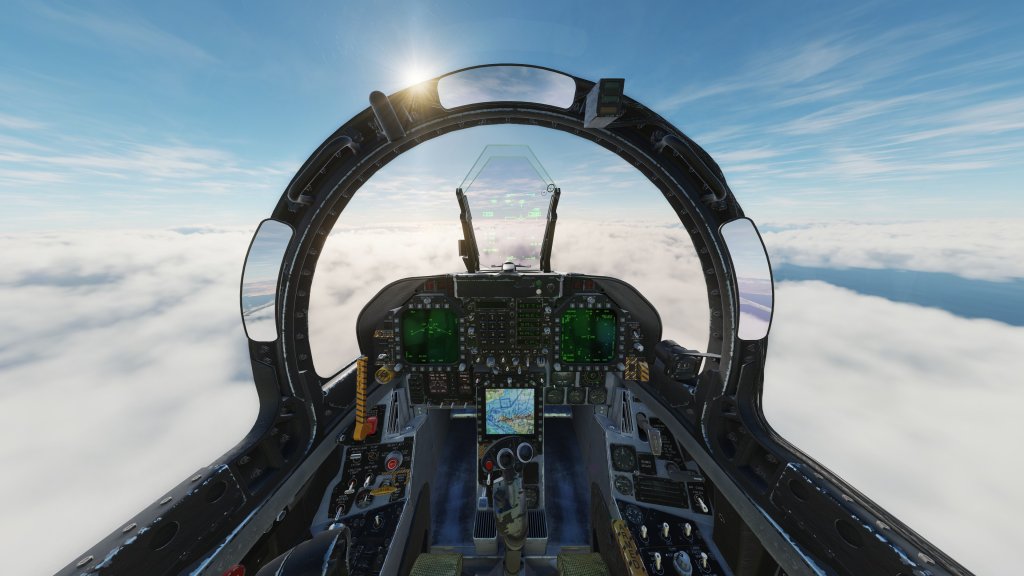

The exterior is the same with quality textures throughout and a ton of liveries that include almost a dozen schemes just for the US Navy and US Marine Corps as well as custom schemes that include Australian, Canadian, Spanish, Swiss, Finnish, and Kuwaiti Hornet schemes. We also have the a Spanish Tigermeet livery, Blue Angels livery and two RCAF demo schemes including the brilliant Canada 150 scheme. They have even done an F/A-18C rendition of Maverick’s Super Hornet from Top Gun: Maverick.







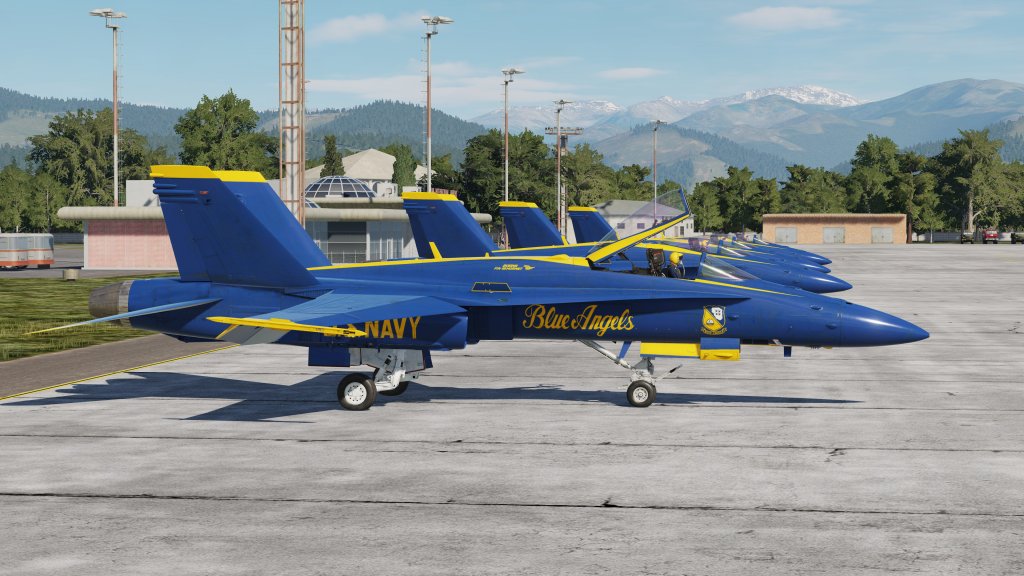
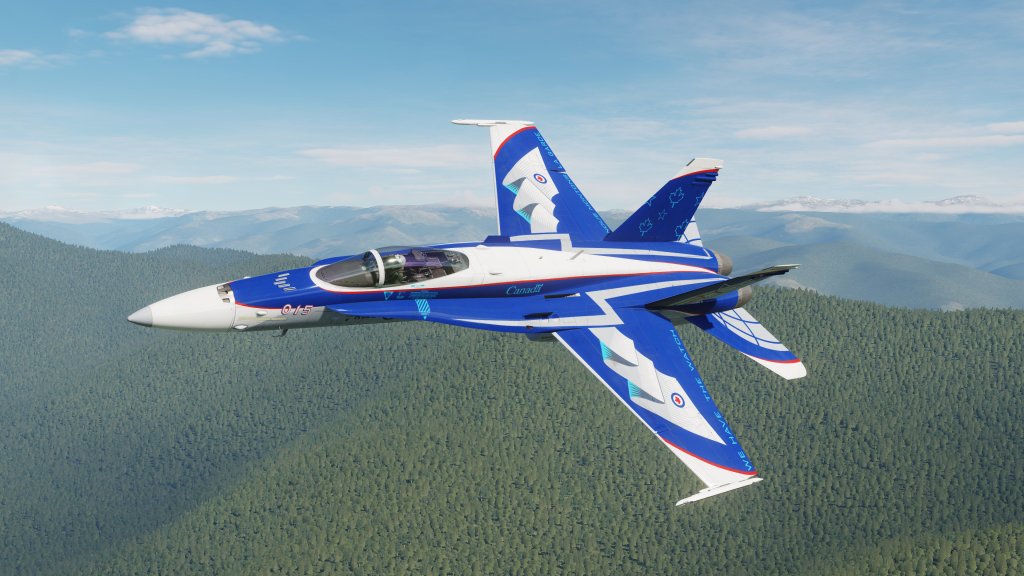
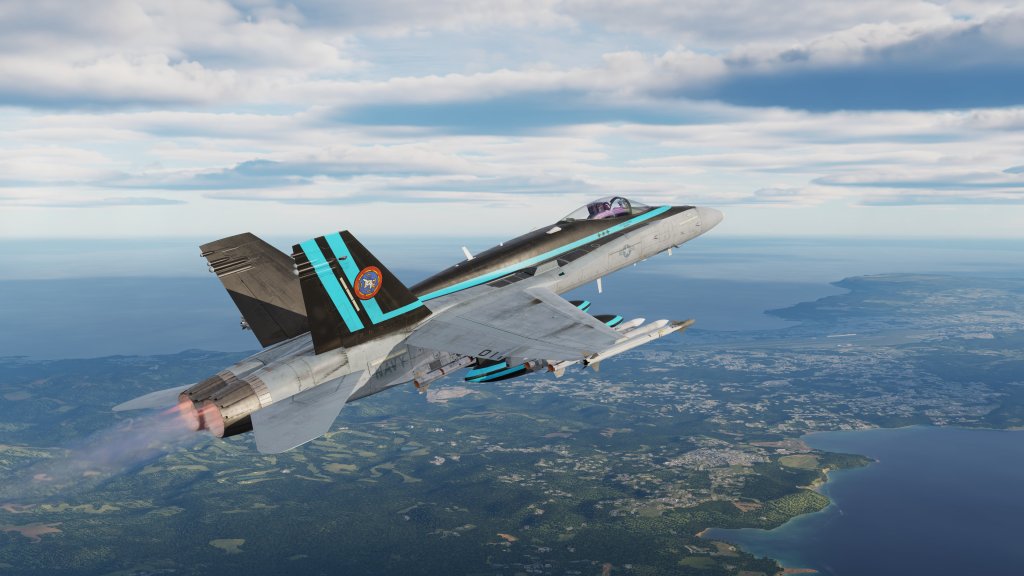


There’s very little to complain about visually with the F/A-18C. Even the formerly overly bright nav lights have been tuned in recent updates.
Same goes for the sounds in the Hornet which are also top notch. Everything from the switches to the APU starting to the characteristic engine start sound are all there. Jet sounds on the exterior are superb too including the Hornet’s howl as it gets pulled through tight turns or when throttling the engine up suddenly during takeoff. The beeps and voice overs from the cockpit are also 100% authentic from Boeing so you can’t get any better than that.
The one miss is in the damage model which remains relatively simple – a problem shared by many DCS modules right now. Eagle Dynamics have committed to a deeper system which has already been integrated into DCS WWII aircraft, however, modern types will eventually see the system too and it’ll be a good thing when it does come. In the meantime the Hornet is typically either fully functional or very damaged or almost entirely destroyed with little in between. Eventually this will improve but for now… it is what it is.
Final thoughts and conclusion
From the depth of the systems to the exquisite nature of the texture and 3D model to the sound work and extensibility with other modules like the DCS: Supercarrier, it is clear that the DCS: F/A-18C Hornet is a great example of the kind of masterpieces that Eagle Dynamics can produce when given enough time.
Since its release in 2017, DCS: F/A-18C has gone through its share of growing pains with both bugs and a lengthy development cycle. To build something so comprehensive and ground breaking takes time and Eagle Dynamics does tend to bite off a number of projects at once. The state of this jet in 2023, however, is definitely at an extremely high level worthy of the high praise heaped on it.
I can already hear a few keyboards going preparing some comments that there are still features that are not yet complete. And that’s true, there are a few things still on the outstanding list. Recent updates have continued to included tweaks and additional features. In truth, I don’t know if any of these modules are ever truly finished and I don’t think any of that should take away from this being an astonishingly fun and authentic simulation of the F/A-18C Hornet.
In nearly every category that we use to compare, I can confidently say that Eagle Dynamics has done a superb job of dialing in the details. There are still quirks or a system that may be needing of a little extra detail but when you look at the whole of this module and compare that to other offerings out there I can easily put this near the top of the list.
It’s worth keeping in mind that although the DCS: F/A-18C might be one of DCS World’s best modules it may also not be for everyone. Some people don’t like the control interface and prefer the A-10C/F-16C way of doing things. Some won’t like the fly-by-wire system and go in search of something more hands on or more analogue like the F-14. Some too don’t like modern jet fighters and the way they are operated at all and prefer the growing collection of Cold War era jets. All of that is fine and all is worth considering when choosing your next (or first) DCS World module.
That all said, if a modern, fourth generation, carrier capable, missile and guided weapon slinging jet fighter sounds like the kind of thing that interests you, it would be hard to point you in any other direction. That’s why the DCS: F/A-18C is both an easy recommendation from me and one of the best and most popular modules for DCS World.
Screenshots

















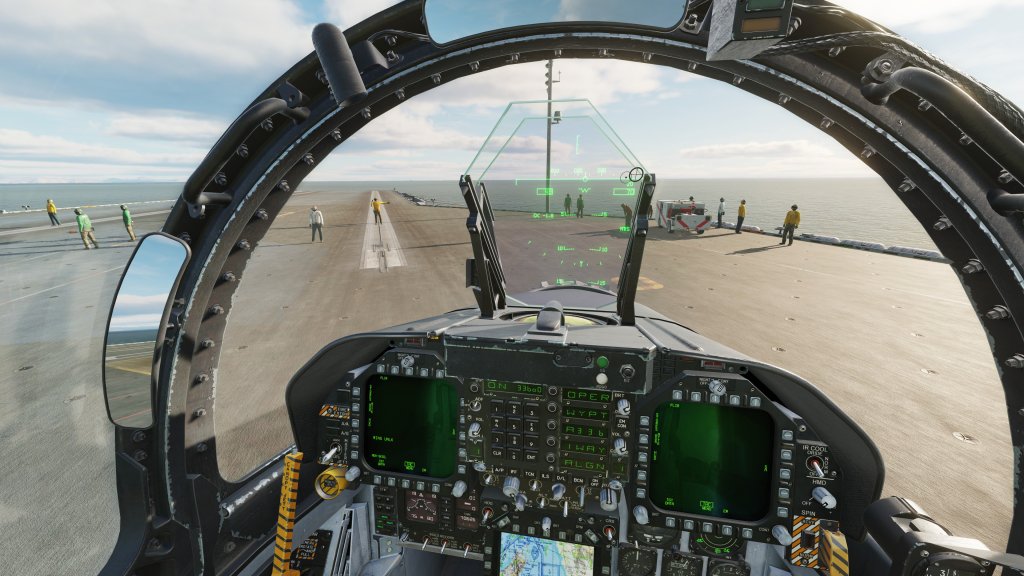




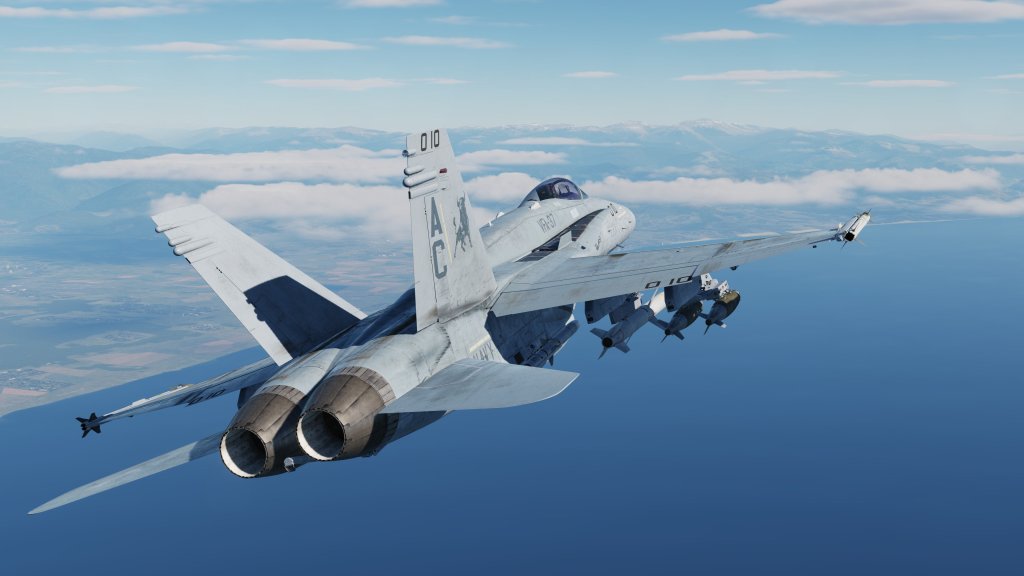



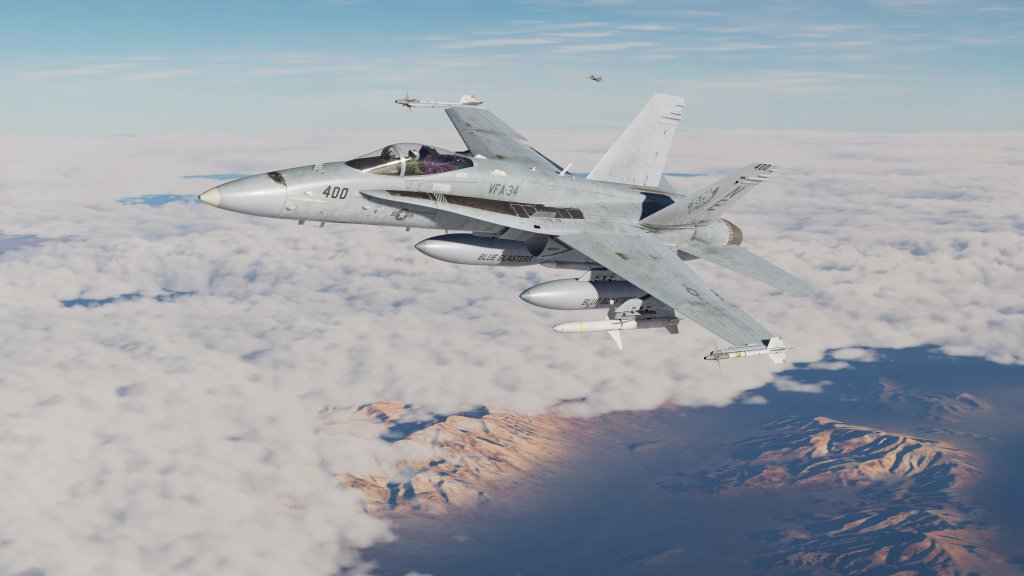
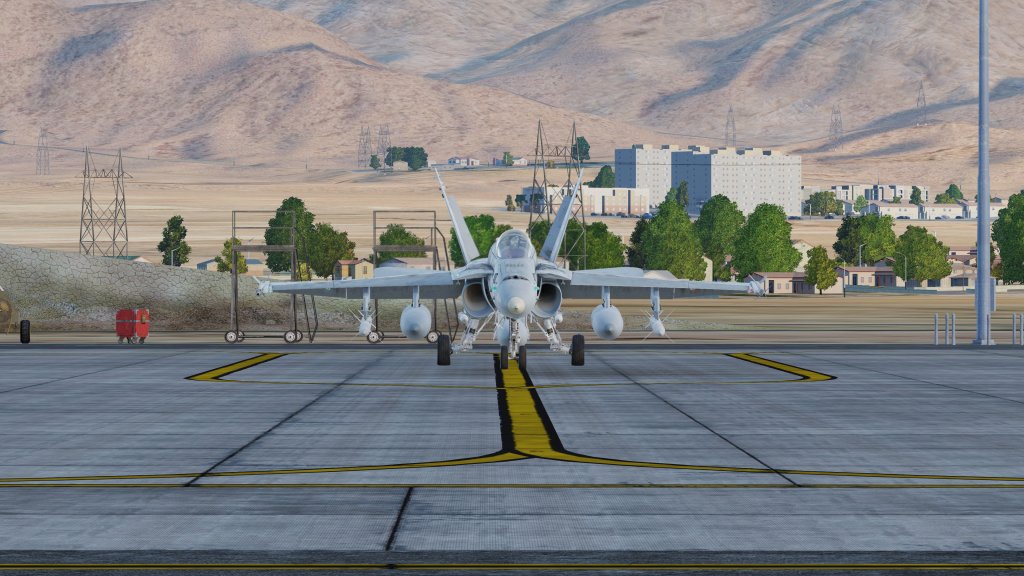



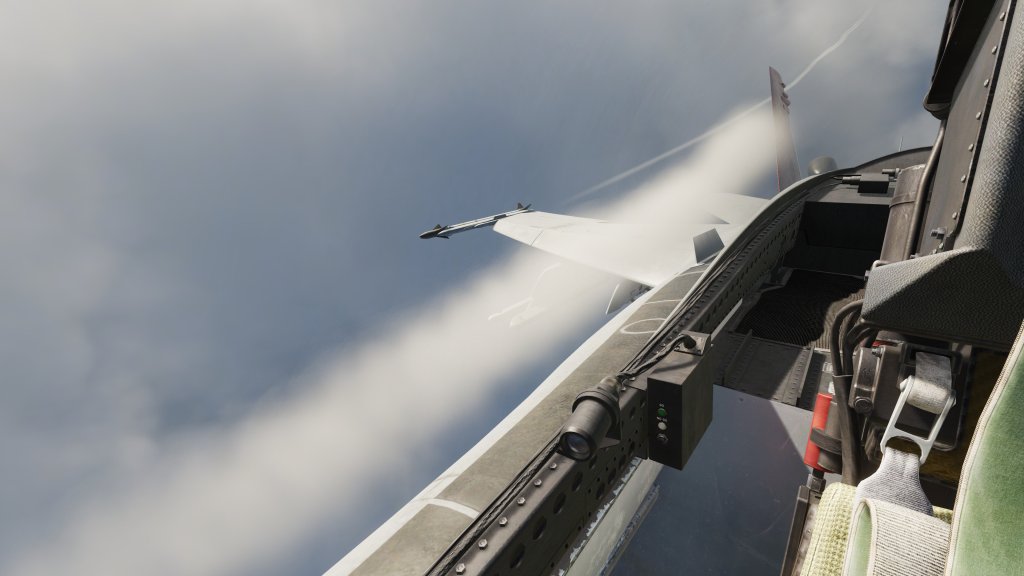


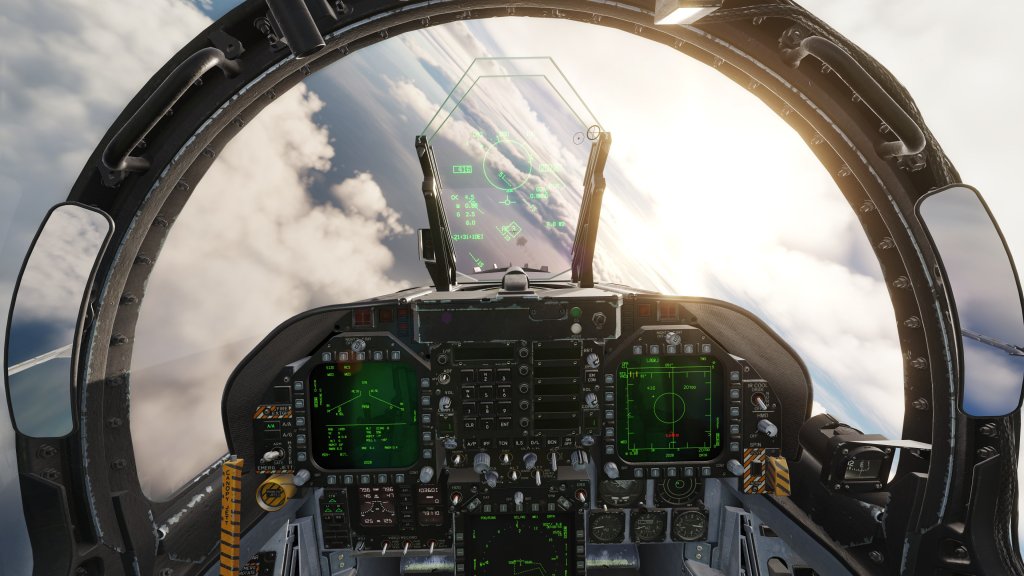








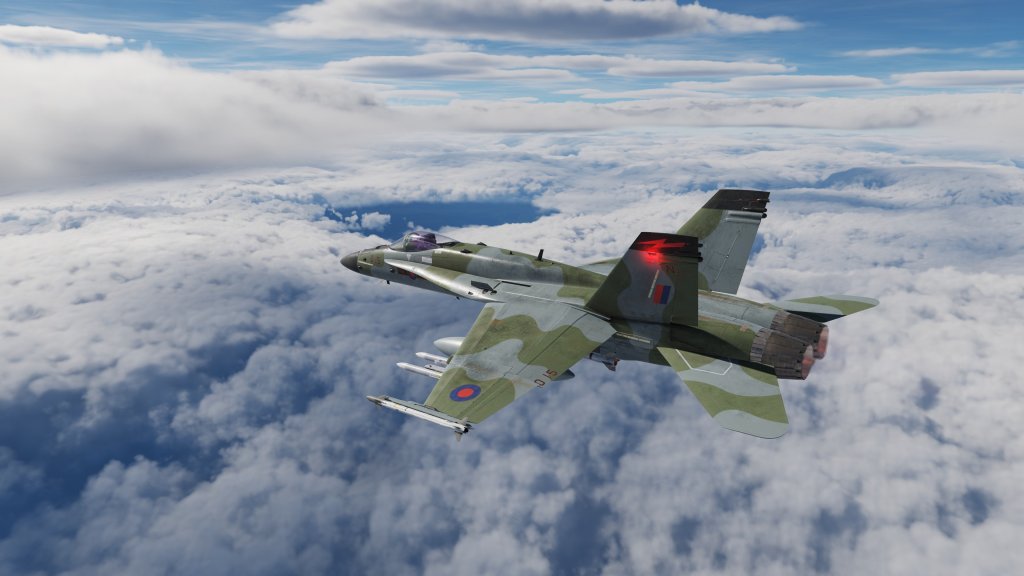















Fly the Hornet in a Stormbirds livery!
My friend Cubeboy over at Skyward Flight Media put together a beautiful livery making use of the Stormbirds colours, logo and a very special shamrock on the vertical stabilizers. It’s a stunning livery and its been one of my private, go-to liveries for the F/A-18 for a while now. With this review I’m pleased to offer it together with Cubeboy for download!

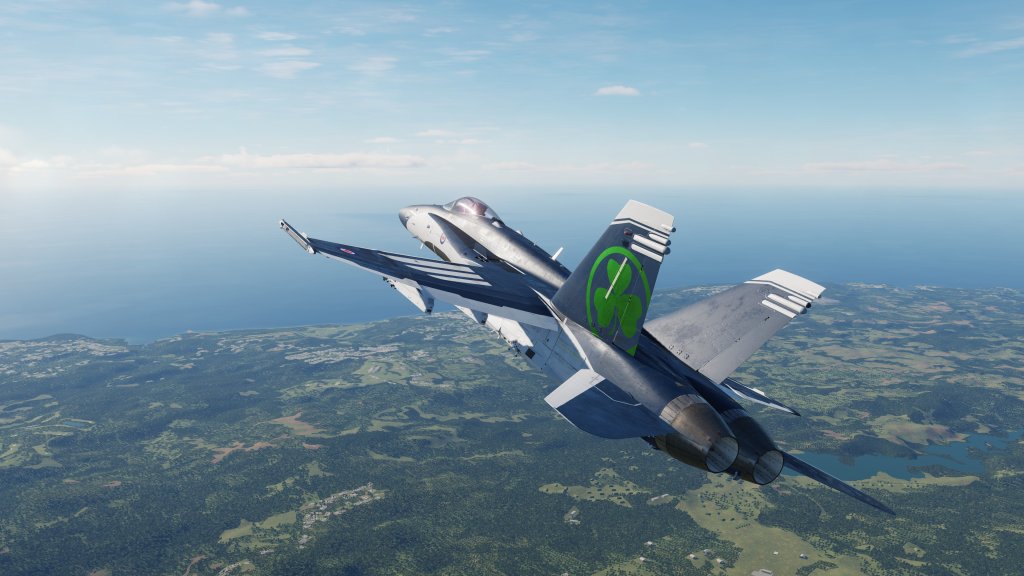
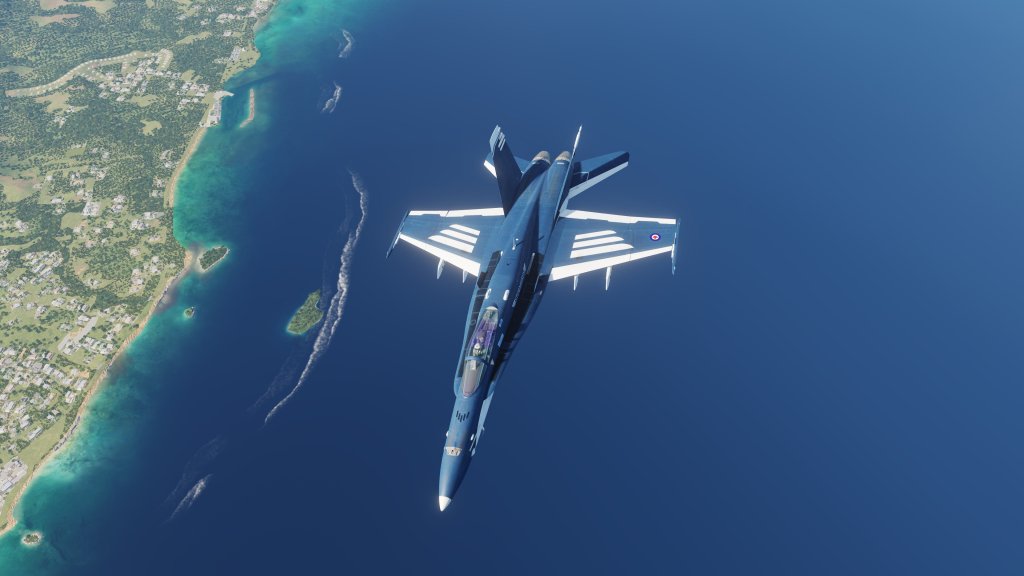

Very capable and fun Aircraft. Jack of all trades I think. Especially love AAR in it. I made a mission for daylight and nighttime AAR and it is a real challenge at night. Leave the carrier and the meet up with the tanker at night with a very low fuel state just to make it interesting ,then land back on the carrier at night. By the time I shut down I cant let go of the flight stick because I have been giving it the grip of death. Or as I’ve read in multiple books from real life pilots they have been trying to squeeze the black out of the flight stick lol. Great review Cheers.
LikeLiked by 1 person
Hah! That’s a great scenario to participate in. Just goes to show the variety and versatility of the aircraft in so many different scenarios. Very fun!
LikeLiked by 1 person
That article was an enjoyable surprise. As was the skin. I’ll try it out in a minute.
I’ve gone more in depth with the Hornet than any other module. I love all the fancy toys. I just set up Voice Attack to run through four mark points and pickle a GBU on each. Once I mark four targets with the pod, I get in range and say “arc light” and it drops the four bombs on the four mark points in quick succession and Voice Attack responds “Boom!” as a confirmation. Realistic? Maybe not. But fun and effective. 🙂
Definitely a very cool plane.
LikeLiked by 2 people
Oh damn that’s VERY cool. I’m of the opinion that if it works for you and its super cool… do it. That voice attack method is great!
Yep, one of the best aircraft in the sim for sure. And there’s no shortage.
LikeLiked by 1 person
Nice skin. Glad to see the maple leaf there. But you’ve got to get a MK84 with “From Stormbirds With Love” on it. It would really seal the deal,
LikeLiked by 1 person
Future addition perhaps!
LikeLiked by 1 person
If you start poking around with Voice Attack, you’ll probably want to give VAICOM Pro a look too. Sounds like the author, Hollywood, open-sourced it so it’s being maintained by the community now.
LikeLike
the F18 is more or less a F16 with harpoon capability and an extra engine. maybe a statement von general aircraft development than the plane itself, but thats how I choose between them.
LikeLike
Don’t really agree with this at all: workflow for many tasks is far different, and the flight profile of both is VASTLY different… not to mention carrier-based vs not!
LikeLike
Great review! Reminds me I need to get VA working.
I like the Hornet in theory but I cannot really love it. Not sure why. The HMI is far superior to the Viper, it can carry more weapons, the sensors are not bad and it offers CV operations. And yet….
Last time I flew it the Link-16 projection via HMD had been introduced (which is Star Wars level of capability). Now running on the Viper?
LikeLike
We’ll have to get a Stormbirds review of Voice Attack. I couldn’t fly DCS without it. I have about 25 or 30 commands for the Hornet – some have 100+ commands – and it frees up a lot of buttons on my HOTAS and saves me from searching on the keyboards.
Every time I think about getting a Stream Deck or other fancy peripheral, I remember I’m not using Voice Attack to it’s full potential. No need for $300 worth of hardware when $10 worth of Voice attack can cover all the bases.
LikeLiked by 1 person
Do you give lessons? 🙂
LikeLike
Lessons for Voice Attack? Oh lord no, I’m not that bright. Fortunately the interface is simple enough so that even people like me can build up something very useful in just a few minutes. Some good tutorials on Youtube.
LikeLiked by 1 person
As for the Hornet, I agree. It surely is a great module, offering a shitload of single player content. So there’s a lot to like, but as you said: “And yet..”.
Mind you, I’m not a Viper guy, either. But I do love my Tomcat. 😎
Oh, and I also strongly recommend Voice Attack.
LikeLiked by 2 people
I think the vote is in: Stormbirds needs to do a Voice Attack article. 🙂
As for the Tomcat, I try to enjoy the plane but it just doesn’t grab me. It’s a gorgeous module though. I can see why some people love it. But the Hornet does grab me. Must be those delicious MFDs and the “Kaboom!” show therein.
LikeLiked by 2 people
On the F-16 you can currently select a datalink contact on the HSD page and it will be displayed on the HMD with some data, distance at least. Sounds like that’s not as much as the Hornet is capable of, but it’s still pretty nice.
LikeLike
Here’s hoping Sedlo doesn’t notice that you spelled his name wrong XD
LikeLiked by 1 person
More importantly… let’s hope that I notice 😉
(never happened :D)
LikeLiked by 1 person
VA review, then?
I really enjoy the content and comments on this blog and they always bring a smile to my face.
It is one of several that I tend to check on waking and it is a good antidote to The Warzone, which is fantastic but often depressing.
LikeLiked by 1 person
I cannot get your livery to work. Install instructions do not work for me. First under user/DCS/ i do not have a Liveries folder, I created one but that did not work. Tried to install under steam/etc/ liveries and under mods, no joy. Any suggestions
LikeLike
Excellent review, I’ve managed some of the systems, for some of the time but really need to take the time to do it more effectively….but there is so much to learn. But it IS good fun
LikeLiked by 1 person
Thanks Davie! It can take a while to dig into all of the systems but it’s definitely worthwhile!
LikeLike